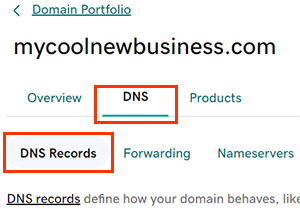Bearbeiten Sie einen SPF-Datensatz
Sie können Ihre SPF-Datensätze (Sender Policy Framework) jederzeit bearbeiten, um zu ändern, welche Mailserver E-Mails im Namen Ihrer Domain senden dürfen. SPF-Records können helfen, E-Mail-Spoofing zu erkennen und zu verhindern . Es kann jeweils nur ein SPF-Record für Ihre Domain funktionieren und wir können keine Anleitung zu benutzerdefinierten SPF-Records geben. Ihre Domain muss GoDaddy-Nameserver verwenden, um einen SPF-Datensatz in Ihrem GoDaddy-Konto zu bearbeiten.
Beispiel: Wenn für Ihre E-Mail Professional Email, Microsoft 365 von GoDaddy, Linux Hosting, Gen 4 VPS & Dedicated Hosting oder Media Temple Mail muss für Ihren SPF-Record der Wert v = spf1 include: secureserver.net -all festgelegt sein , damit er ordnungsgemäß funktioniert.
- Melden Sie sich bei Ihrem GoDaddy-Domain-Portfolio an. (Sie benötigen Hilfe bei der Anmeldung? Benutzername oder Passwort ermitteln.)
- Wählen Sie eine einzelne Domain aus, um auf die Seite Domain-Einstellungen zuzugreifen.

- Wählen Sie DNS , um Ihre DNS-Records anzuzeigen.

- Wählen Sie
 Bearbeiten neben dem Eintrag aus, den Sie bearbeiten möchten.
Bearbeiten neben dem Eintrag aus, den Sie bearbeiten möchten. - Bearbeiten Sie die Details für Ihren SPF-Record.
- Name : Der Hostname oder das Präfix des Datensatzes ohne den Domainnamen. Geben Sie & commat; , um den Datensatz in Ihrer Root-Domain zu platzieren, oder geben Sie ein Präfix wie mail ein. Der Name muss den folgenden Richtlinien entsprechen:
- Punkte (.) sind zulässig, jedoch nicht als erstes oder letztes Zeichen
- Aufeinanderfolgende Punkte (…) sind nicht zulässig
- Bindestrich (& # 45;) kann nicht beginnen oder enden
- 63 Zeichen in einer Zeile, die nicht durch einen Punkt getrennt sind (& # 46;)
Beispiel: 63characters.63characters.coolexample.com
- Maximal 255 Zeichen
- Wert : Die SPF-Regel, die angibt, dass E-Mails nur von Ihrem Mailserver aus zulässig sind. Der Wert muss den folgenden Richtlinien entsprechen:
- Maximal 512 Zeichen sind zulässig
- Nur ASCII-Zeichen sind zulässig
- Professional Email, Microsoft 365 von GoDaddy, Linux Hosting, Gen 4 VPS & Dediziertes Hosting und Media Temple Mail verwenden den folgenden SPF-Record:
v=spf1 include:secureserver.net -all - Wenn Sie Microsoft 365 von GoDaddy und das Add-on für erweiterte E-Mail-Sicherheit haben, gehen Sie zu E-Mail & Office-Dashboard , um Ihren SPF-Datensatz zu finden.
- TTL (Time to Live) : Die Zeit, die der Server vor der Aktualisierung im Cache speichern muss. Die Standardeinstellung ist 1 Stunde.
- Name : Der Hostname oder das Präfix des Datensatzes ohne den Domainnamen. Geben Sie & commat; , um den Datensatz in Ihrer Root-Domain zu platzieren, oder geben Sie ein Präfix wie mail ein. Der Name muss den folgenden Richtlinien entsprechen:
- (Optional) Wählen Sie Weitere Datensätze hinzufügen, um mehrere DNS-Datensätze gleichzeitig hinzuzufügen. Wenn Sie Ihre Meinung ändern, wählen Sie
 Löschen , um alle noch nicht gespeicherten Datensätze zu entfernen.
Löschen , um alle noch nicht gespeicherten Datensätze zu entfernen. - Wählen Sie Speichern , um Ihre Änderungen zu bestätigen. Wenn Sie mehrere Datensätze gleichzeitig hinzugefügt haben, wählen Sie Alle Datensätze speichern . {% Include "domains-otpnote-v1"%}
Die meisten DNS-Updates werden innerhalb einer Stunde wirksam, die globale Aktualisierung kann jedoch bis zu 48 Stunden dauern.
Ähnliche Schritte
- Erfahren Sie, wie SPF-Records dazu beitragen können, E-Mail-Spoofing zu verhindern .
- Fügen Sie Ihrer Microsoft 365-Organisation DKIM-Records hinzu.
- Sie können SPF-, DKIM- oder DMARC-Records auch zu Linux Hosting, Gen 4 VPS Hosting und Dedicated Hosting hinzufügen.
Mehr Info
- Erstellen Sie eine DNS-Vorlage , um schnell DNS-Records auf Ihre Domains anzuwenden.
- Aktivieren Sie die automatische Verlängerung, damit die Domainregistrierung ohne Unterbrechung weiterlaufen kann.
- Richten Sie die zweistufige Verifizierung für die beste Sicherheit für Ihre Domains und Ihr Konto ein.